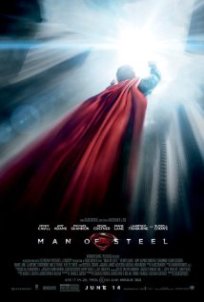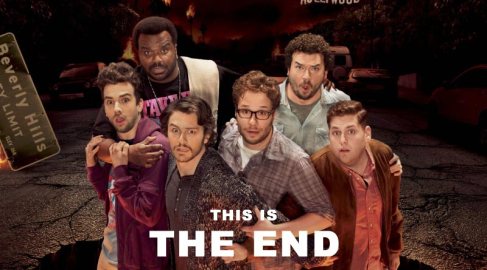Monthly Archives: June 2013
29/06/13 Apocalypse Not: Theological Musings and “This is the End.”
“This is the End” contains the signatures of a typical Seth Rogen stoner brofest except the cast plays themselves and the movie occurs during the apocalypse. Seth Rogen, Jay Baruchel, James Franco and Jonah Hill poke fun at celebrity life while struggling to avoid starvation and demonic forces. The movie is two hours of marijuana jokes, celebrity cameos, demonic possessions, and, since this movie is about homosocial bonding, a lot of penis jokes. The movie is hilarious if you don’t mind the crassness of it all. In the midst of this ridiculousness, come significant questions about eternity. Is God real? How does the world end? What does it mean to be a good person? How do we get to heaven?
Jay is first to figure out the destruction occurring around them is the result of the Biblical apocalypse. He sees people being taken up to the sky by blue beams of light. It’s textbook rapture imagery as people are lifted right out of the streets and driverless cars crash into buildings. It’s what the “Left Behind” movies would’ve done if they had a budget. Initially, no one believes Jay, especially since none of the celebrities at James Franco’s house go missing. Emma Watson thinks it’s a zombie apocalypse, Danny McBride thinks the Lakers just won.
Jay finds passages from the Bible to corroborate his story. Ironically, the passages he reads describing burning mountains and roving demons are not actually in the Bible. The lack of accuracy is likely done for the sake of drama, but it’s indicative of something larger in our culture. We live in a culture informed by the Bible, but also oblivious to it. Demons, hell, and heaven are common motifs for most Americans, but a majority of people would be hard pressed to cite Biblical examples of these things. Seth and company represent this disconnection. We as a culture can easily identify heralds of good and evil but are terribly lacking on specifics. What’s God like? What happens in heaven? Much like Seth’s friends, we have our own ideas, but we can’t be bothered to look up anything.
Once they conclude that this is judgment day, the group realizes they are in serious trouble. Seth laments that he would’ve lived differently if he knew God was real. They soon wonder what they did to deserve being abandoned, and how they can get captured in those saving blue beams of light. I never thought I’d see the cast of “Superbad” discussing real theological questions, but why shouldn’t they? We all do at one point or another.
Without giving too much away, the cast puts their hope in being nice to each other and trying to follow the Ten Commandments so that they can “go into the light.” It’s not a bad plan, and it leads to fun moments as the cast fumbles around trying to remember commandments and selfishly save themselves by saving each other. Their plan reveals more misperceptions of the gospel. The Bible states that we can’t earn our way into heaven through good deeds, however. “It is by grace you have been saved, through faith – and this is not from yourselves, it is the gift of God,” according to Ephesians. It’s not based on on our efforts but on God’s mercy. The characters represent the misperception that Christianity is rule based and that entry into heaven depends on a celestial scorecard.
The film’s depiction of heaven also holds a mixture of scripture and misperception. The film depicts heaven as a literal paradise. It looks like an all ages spring break party with roller coasters and concerts. The characters are thrilled to find people they know there ready to welcome them. This plays on two deeply ingrained Christian ideas. First, biological and Christian family members will be there to greet the dead, and secondly, getting left behind during the rapture is the worst thing ever. Ask your Christian friends about the latter. I bet they’ve all had nightmares about it. The film takes these ideas and gives it a more carnal turn where the elect are rewarded with an endless dance party.
I went to “This is the End” because I wanted to see a comedy with celebrities playing themselves during the end of the world. I got that, but I wasn’t expecting real theological questions and musings over eternity. In between the laughter, I found something deeper. This film represents how the unreligious see Christianity and manifests common anxieties about the end of the world. “This is the End” gives us the afterlife that we all want, even Christians. Good people get saved, and heaven is a gigantic party with all your friends. Everyone gets saved, and ultimately, we can live the life we want on Earth with little cost. God doesn’t demand obedience or holiness; he just wants us to have fun. The film is ultimately a form of wish fulfillment.
A few weeks ago, I went to a preview screening of “Man of Steel” targeted at religious groups. The studio wanted to market the film to Christian audiences and play up the parallels between Jesus and Superman. “This is the End,” an apocalyptic stoner comedy with a hard R rating, can spark genuine discussion about eternity better than Zack Snyder’s heavy handed Christ imagery. Religious groups should be watching Seth and his friends blunder their way through judgment day if they can stomach the raunchy humor. “This is the End” offers a revealing look at how nonbelievers view Christianity and can provide an irreverent beginning for good conversations about faith.
–Prof. F.
Tags: Christianity, movies, reviews, This is the End
- 2 comments
- Posted under uncategorized
12/06/13 Man of Steel Review
 Hollywood is not known for originality these days, but it’s interesting that two tentpoles for the summer of 2013 are reboots that borrow heavily from the franchises that preceded them. “Star Trek Into Darkness” (spoiler alert) gets its inspiration from “Star Trek II: The Wrath of Khan” and “Man of Steel” gives us a brand new Superman fighting an old villain, General Zod. There’s a fine line between homage and plagiarism. “Star Trek Into Darkness,” unfortunately goes where the franchise has gone before while “Man of Steel” pushes a familiar storyline into new territory.
Hollywood is not known for originality these days, but it’s interesting that two tentpoles for the summer of 2013 are reboots that borrow heavily from the franchises that preceded them. “Star Trek Into Darkness” (spoiler alert) gets its inspiration from “Star Trek II: The Wrath of Khan” and “Man of Steel” gives us a brand new Superman fighting an old villain, General Zod. There’s a fine line between homage and plagiarism. “Star Trek Into Darkness,” unfortunately goes where the franchise has gone before while “Man of Steel” pushes a familiar storyline into new territory.
Director Zack Snyder touches on all of the traditional plot points: Kal-El is sent to Earth as Krypton faces destruction; Zod and his cronies are banished to the Phantom Zone. Superman fans know the deal for the most part. Snyder’s original touches come with the sumptuous visuals and lavish production designs for the doomed Kryptonian society. While other Superman ventures have moved chronologically to find our hero working at the Daily Planet, Snyder opts to show us Clark as a disenfranchised adult, moving disconnectedly around the globe, helping and hiding wherever he can. We see flashbacks to Clark’s life in Kansas, his two loving parents and his own search for his purpose and his identity.
Then we get action scenes… and fighting. Lots and lots of fighting. Snyder’s frenetic action scenes finally come when Zod and his soldiers arrive to turn Earth into a new Krytpon at the cost of destroying humanity. Where Christopher Reeve’s Superman flew with grace and almost a balletic poise, Henry Cavill takes to the air with brute force. This is a Superman that breaks the sound barrier when he flies and leaves contrails in his wake. This is a Superman who engages in brutal hand-to-hand combat. The last third of the movie is basically a meta-human street fight. The overreliance on CGI is a bit distracting, but if you’re a fan, this what you’ve been wanting to see a live action Superman do, finally.
One thing the movie does lack is character development. Snyder gives us a Clark that’s a loner, a nomad, wandering geographically and spiritually until he finds his purpose in life. We also get a tenacious Lois Lane who’s on Clark’s trail. We know that Clark and Lois will get together, but Snyder never shows us any real bonding moments. They bond over danger, but why does Clark fall for her? He’s presumably saved women throughout his lifetime, what’s special about Lois? In fact, I would think that Clark might be annoyed at how determinedly Lois follows him around. For a guy who spends the early part of the movie avoiding people, he accepts her presence pretty quickly. These are small quibbles though. The movie sets up enough room for growth in the sequel.
It’s not easy to reboot a franchise and it’s certainly not easy to do it with Superman. The last effort by Bryan Singer sought to be a continuation of the Christopher Reeve series but suffered from bad casting (see Kate Bosworth), odd character development (Superman as a creepy, deadbeat dad), and a lack of action scenes. C’mon, it’s Superman. We want to see him pummel a villain, not deal with Lex Luthor’s real estate schemes. Now we have Zack Snyder’s incarnation, a Superman wise enough not to show off his powers but not afraid to punch someone through a building when needed. Finally, the Superman we’ve been waiting for.
–Prof. Fail
Tags: Superman Review
- Leave a comment
- Posted under uncategorized
